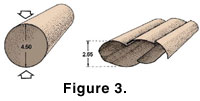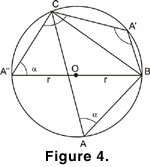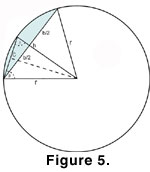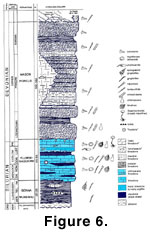METHODOLOGY
 The crushing of the cephalopod fossils is mostly a clastic deformation transforming their original circular geometry in an
The crushing of the cephalopod fossils is mostly a clastic deformation transforming their original circular geometry in an  overlapping of conical fragments in the same way
as some house-roofing tiles
(Figure 2 and Figure
3). Provided one can assume that the orthocone shell was deformed from an initially circular cross-section, the Chord of the Arc of Conjecture Method can be used to estimate the radius of the original circle from measurements obtained from arc segments.
overlapping of conical fragments in the same way
as some house-roofing tiles
(Figure 2 and Figure
3). Provided one can assume that the orthocone shell was deformed from an initially circular cross-section, the Chord of the Arc of Conjecture Method can be used to estimate the radius of the original circle from measurements obtained from arc segments.
Given a circle (Fig. 4) of radius r and its center at O, two randomly chosen points along its circumference (B and C) define an arc-segment whose basal chord is  . It is now possible to draw a line from B through the origin (O)
so we can obtain the position of point A'' which represents the third vertex of the right triangle CA''B that subtends the chord
. It is now possible to draw a line from B through the origin (O)
so we can obtain the position of point A'' which represents the third vertex of the right triangle CA''B that subtends the chord  . Let us call the magnitude of the angle represented by this vertex
. Let us call the magnitude of the angle represented by this vertex  .
.  From these geometric relations it follows that
From these geometric relations it follows that  .
.
If we now consider a point (A') between points B and C such that BA''CA' forms a quadrilateral, we may infer the magnitude of the angle BA'C as  because of the fact that every quadrilateral inscribed in a circle has supplementary opposite angles.
because of the fact that every quadrilateral inscribed in a circle has supplementary opposite angles.
 Thus, in every circumference of centre O and radius r, the length of a chord is equal to the length of the diameter multiplied
by the sine of the angle that subtends the chord. This, in turn, means that information sufficient to estimate radius of any circle is contained in the geometry of any arc segment.
Thus, in every circumference of centre O and radius r, the length of a chord is equal to the length of the diameter multiplied
by the sine of the angle that subtends the chord. This, in turn, means that information sufficient to estimate radius of any circle is contained in the geometry of any arc segment.
Using appropriate geometrical analyses (see Fig.
5) it is possible to estimate this radius using either angular or linear data
(Fig. 5A and Fig.
5B respectively). In most cases, however, it will be best to base the final estimate on the average radius estimates from sets of arcs rather than relying on single calculations.
 Once these estimates have been obtained, comparison between the estimated diameter of the body chamber with the thickness of that preserved in the sediment
(Fig. 6) will yield an approximate value of the lithological unit's taphonomic-tectonic compaction.
Once these estimates have been obtained, comparison between the estimated diameter of the body chamber with the thickness of that preserved in the sediment
(Fig. 6) will yield an approximate value of the lithological unit's taphonomic-tectonic compaction.

 The crushing of the cephalopod fossils is mostly a clastic deformation transforming their original circular geometry in an
The crushing of the cephalopod fossils is mostly a clastic deformation transforming their original circular geometry in an  overlapping of conical fragments in the same way
as some house-roofing tiles
(Figure 2 and Figure
3). Provided one can assume that the orthocone shell was deformed from an initially circular cross-section, the Chord of the Arc of Conjecture Method can be used to estimate the radius of the original circle from measurements obtained from arc segments.
overlapping of conical fragments in the same way
as some house-roofing tiles
(Figure 2 and Figure
3). Provided one can assume that the orthocone shell was deformed from an initially circular cross-section, the Chord of the Arc of Conjecture Method can be used to estimate the radius of the original circle from measurements obtained from arc segments.
 .
. 

